Carry(ing) the Innovation Forward
We will focus our priorities for 2021-2023 on sustaining and advancing the learning innovations brought forth out of necessity during the COVID-19 pandemic of 2020-21. Duke faculty, staff and students embraced change and sought to build purpose and meaning through the adoption of new teaching methods, new learning technologies and new ways of staying connected while being forced apart. While the eventual end of the pandemic will bring about much to celebrate, we also know that in times of great distress and pressure, new innovations can emerge.
In Spring 2021, we launched a new program – Carry the Innovation Forward – to help advance Duke’s progress in transforming post-pandemic teaching and learning. Over the next two years, we will commit some of our resources to projects selected through this program. The program encompasses four thematic areas we want to continue to impact:
- Research on innovative learning
- Exploration of new technology
- Re-envisioning a course or program for flexible or online learning
- Faculty Learning Communities
See the CIF page for more details and examples.
The themes and ‘spirit’ of Carry the Innovation Forward — particular program and selected projects aside — will also direct our priorities for the next two years.
Priority Areas
Promote principles and themes of Diversity, Equity, Inclusion and Accessibility (DEIA) as they apply to innovations in teaching and learning
We continue to educate ourselves on and integrate inclusivity and equity-based design principles for learning into our support for both classroom teaching and online learning projects. We will partner with faculty and staff to make learning experiences more equitable and inclusive, and maximize accessibility to students of all backgrounds and needs.
Future-proof Duke’s learning technologies ecosystem
The pandemic taught faculty how to better use standard technologies like Sakai and Zoom to connect with and engage students. Many faculty also employed new tools and technologies to address unexpected challenges. From that baseline, we will focus on identifying gaps, improving usability and accessibility, and empowering more learners through better access, availability, efficiency and/or design.
Create more online learning opportunities for Duke; help more learners learn from Duke online
Digital learning offers us the ability to not only transform learning for traditional students, but to expand and create new opportunities to meet the continuous learning needs of Duke students, alums and our broader communities. We will continue to partner with Duke schools and faculty to design, develop and offer transformative digital learning experiences for Duke students in and outside of the classroom. Furthermore, we will extend Duke’s impact to new professional and lifelong learners through increased experimentation with new models that expand access and increase flexibility for more learners.
Increase Duke’s research on teaching and learning
As we focus on carrying the innovation forward, the time is right to challenge old assumptions about the efficacy of our pre-pandemic teaching and learning practices, as well as test and examine carefully new and emerging ideas, tools and strategies for improving learning. Coming out of the pandemic, we will continue to support faculty who want to research new innovations in teaching and learning and develop new approaches to instructional challenges.
Create new professional development and community-building opportunities for Duke faculty
We believe learning happens in networks of colleagues, cohorts, peers – in communities of practice, not hierarchies. During the pandemic, Duke’s teaching and learning community came together like never before to address challenges and meet the changing needs of our students. With the momentum from the Flexible Teaching effort, we will engage faculty in new professional development programs and communities that continue to build upon newly acquired skills and practices.

